Building the right tech stack for your product is crucial in software development. A well-constructed technology stack serves as the foundation for your web application, enabling it to deliver a seamless user interface and meet the evolving demands of your users. However, choosing the right technology stack can be daunting, as it involves navigating a vast landscape of programming languages, web servers, and backend technologies. Challenges abound, from selecting the appropriate runtime environment to ensuring scalability and security.
Aloa, an expert in software outsourcing, helps businesses and startups easily navigate these challenges. We understand your chosen technology stack can significantly impact your project's success. Our experienced team guides you through decision-making, ensuring your technology stack aligns perfectly with your business goals and project requirements.
This comprehensive guide will explore how to build your product's tech stack. We'll delve into the core features that should be considered for both admin and user interfaces. You'll discover the benefits of a well-structured technology stack and gain insights into modern best practices. This will enable you to build a robust and scalable software solution that meets your user's expectations and business needs.
Let's dive in!
7 Steps to Build Your Product's Tech Stack
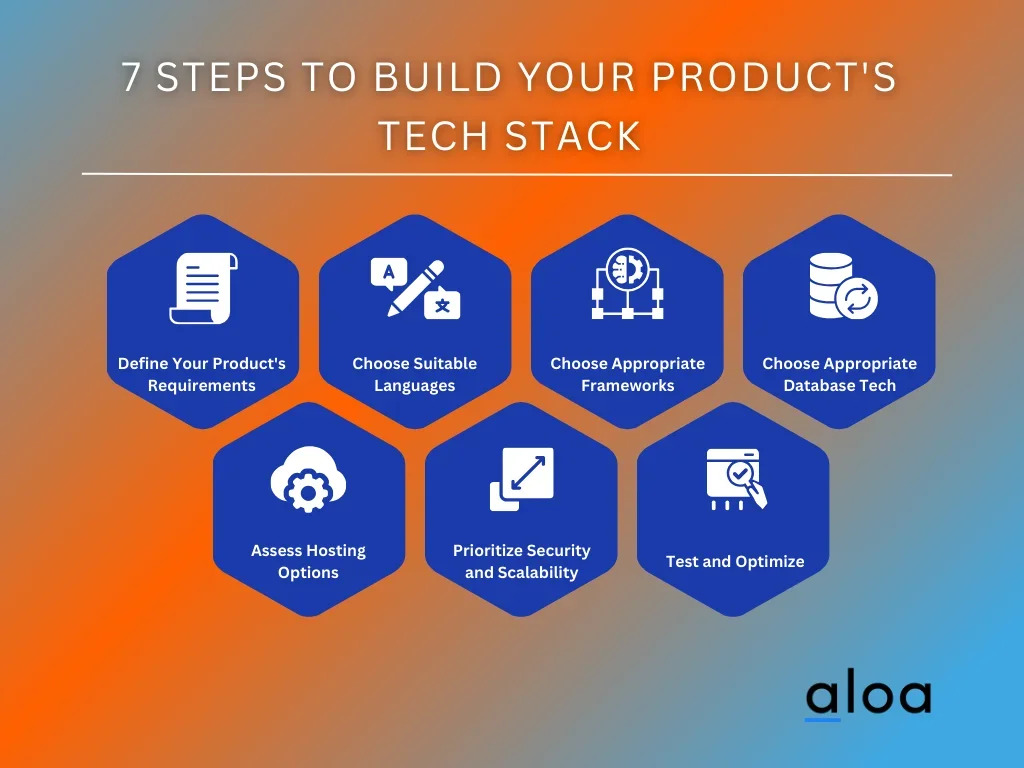
Building a tech stack for your product is a crucial step in the development process. It involves selecting the right technologies, tools, and frameworks to ensure your product's functionality, scalability, and performance. Here are seven steps to help you build your product's technology stack:
Step 1: Define Your Product's Requirements
Before you build your product's tech stack, it's essential to lay a solid foundation by defining your product's requirements. This crucial step sets the stage for a successful development process and ensures that your tech stack aligns perfectly with your goals. Here are some key questions to consider:
- What are the core features and functionalities your product must have?
- What performance expectations do you have for your product, both in terms of speed and responsiveness?
- Are there scalability needs to accommodate potential growth?
- Do you require integration with external systems or services?
- What are the security and compliance requirements for your product?
By addressing these questions comprehensively, you gain a clear understanding of the specific needs and constraints of your project. This knowledge forms the basis for making informed decisions when choosing the components and technologies that will comprise your tech stack. Defining your product's requirements is the first crucial step toward building a tech stack that genuinely serves your objectives and end-users.
Step 2: Choose the Suitable Programming Languages
Selecting suitable programming languages is pivotal in building a well-structured tech stack for your product. Your choice should align seamlessly with your project's goals and specific requirements. To make an informed decision, consider several essential factors:
- Developer Expertise: Assess the proficiency of your development team in various programming languages. Opt for languages they are comfortable with to ensure efficient development and easier problem-solving.
- Community Support: Look for programming languages with robust and active communities. A strong community means access to a wealth of resources, libraries, and support, which can accelerate development and troubleshooting.
- Technical Compatibility: Evaluate whether the chosen programming languages can meet your product's technical demands. Consider scalability, performance, and integration with other technologies in your tech stack.
Commonly used programming languages in technology stacks include
- Python: known for its versatility and ease of use
- JavaScript: a staple for web development
- Java: known for its platform independence
- Ruby: known for its simplicity, productivity, and many more tailored to specific needs.
When making such a crucial decision, partnering with a trusted development company like Aloa is beneficial. Our expertise in various programming languages ensures we can craft a technology stack that perfectly suits your project's unique requirements. Consider Aloa, your development partner, and build a tech stack that propels your product to succeed.
Step 3: Pick the Appropriate Frameworks and Libraries
When building your product's tech stack, one crucial step is carefully selecting the frameworks and libraries that will form the backbone of your development process. This decision can significantly impact your project's efficiency, scalability, and success.
It's often wise to leverage existing frameworks and libraries to accelerate development and avoid reinventing the wheel. These established tools have a wealth of documentation, a strong community, and proven reliability. Consider picking the popular frameworks. Each framework brings unique features and capabilities to the table. Here are the popular frameworks:
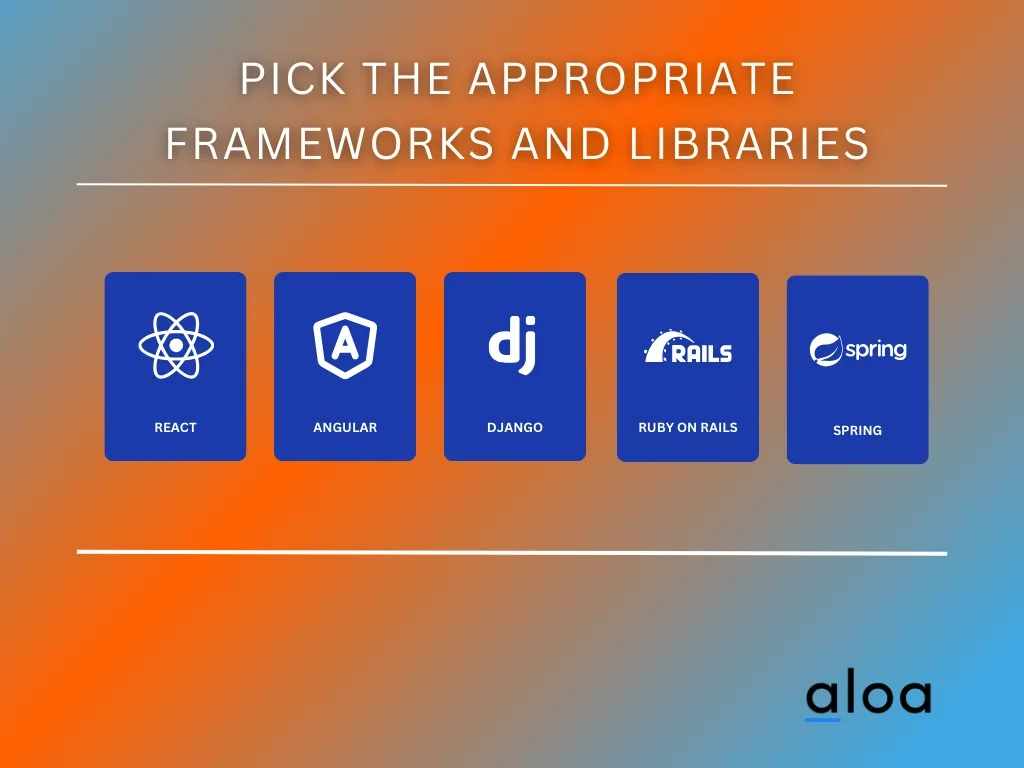
- React: Known for its flexibility and excellent performance, React is a top choice for building dynamic user interfaces in web and mobile applications.
- Angular: Angular is a comprehensive framework ideal for building large-scale web applications with robust features and maintainability.
- Django: If you're developing a Python-based web application, Django's batteries-included approach can save you time and effort.
- Ruby on Rails: A favorite among startups, Ruby on Rails offers a convention-over-configuration approach, simplifying web development.
- Spring: For Java-based applications, Spring provides a comprehensive ecosystem for building scalable and maintainable software.
These frameworks can provide the necessary structure and standard functionality to your project, allowing you to focus on delivering value to your users while maintaining code quality and efficiency. Make your choice wisely to ensure your tech stack aligns seamlessly with your product's goals.
Step 4: Select the Right Database Technology
Selecting the right database technology is pivotal in building your product's technology stack. Your choice should align seamlessly with your data storage and retrieval needs, ensuring efficiency and scalability. Here are some considerations and options to guide you in this crucial decision:
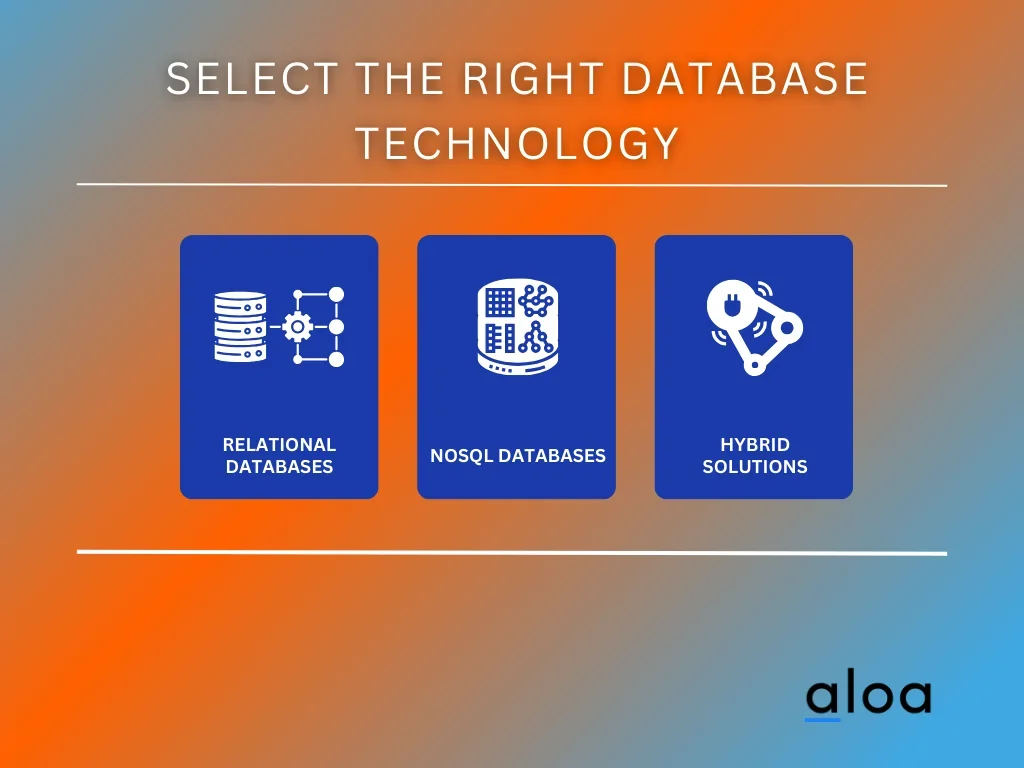
- Relational Databases: Relational databases, such as MySQL and PostgreSQL, are well-established choices for structured data. They excel in handling complex relationships and maintaining data integrity. Consider them if your product relies heavily on structured data or transactions.
- NoSQL Databases: NoSQL databases like MongoDB and Cassandra are ideal for handling unstructured or semi-structured data. They provide flexibility and scalability, making them suitable for applications with rapidly evolving data needs or large volumes of data.
- Hybrid Solutions: In some cases, a hybrid approach, combining the strengths of both relational and NoSQL databases, may be beneficial. This can be particularly useful when your product requires diverse data storage solutions to meet different needs.
When making your decision, prioritize factors like data complexity, scalability requirements, and the specific use cases of your product. Additionally, consider your development team's expertise in managing and optimizing the chosen database technology. By carefully evaluating these aspects, you can ensure that your product's database system is the perfect fit for your project's success.
Step 5: Consider infrastructure and hosting options:
When building your technology stack for your product, one crucial step that demands careful consideration is choosing the proper infrastructure and hosting options. This decision will significantly impact your application's performance, scalability, and efficiency. Here's what you need to know:
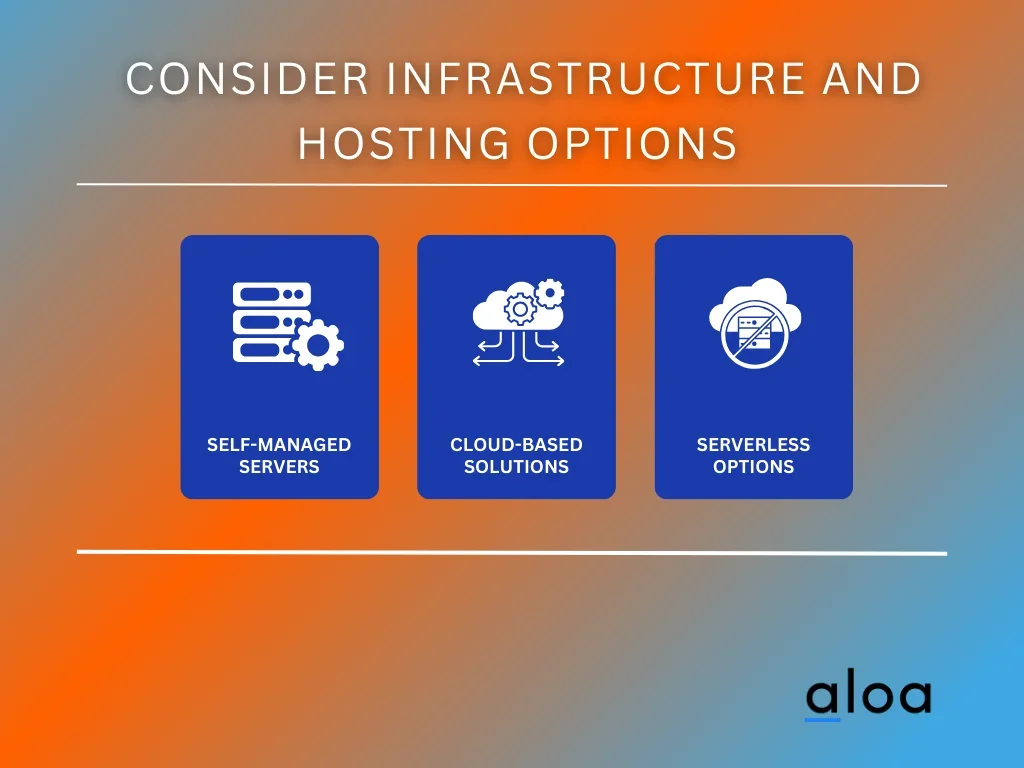
- Self-Managed Servers: Managing your servers provides excellent control over your infrastructure. It's a suitable option for organizations with specific security or compliance requirements. However, it comes with added maintenance, updates, and scaling responsibilities.
- Cloud-Based Solutions: Cloud computing has revolutionized the way applications are hosted. Amazon Web Services (AWS), Microsoft Azure, and Google Cloud Platform (GCP) offer flexible and scalable infrastructure solutions. Cloud providers handle hardware maintenance, ensuring your focus remains on development and innovation.
- Serverless Options: Serverless computing takes the burden of server management entirely off your shoulders. Platforms like AWS Lambda and Azure Functions allow you to focus solely on your application's code, leaving infrastructure management to the cloud provider.
Choosing the right option depends on your project's specific requirements. Consider factors like budget, scalability needs, security concerns, and the technical expertise of your team. The flexibility offered by cloud-based solutions and serverless options can simplify infrastructure management and allow you to scale seamlessly as your product grows. Make this decision wisely to ensure your technology stack effectively serves your project's long-term goals.
Step 6: Prioritize Security and Scalability
Prioritizing security and scalability within your technology stack is crucial. Safeguarding user data and the overall integrity of your application should be at the forefront of your development strategy.
Security should be woven into the very fabric of your technology stack. Incorporate robust authentication and authorization mechanisms, data encryption, and regular security audits to protect sensitive user information. Implementing security best practices will fortify your application and build user trust.
Scalability is equally vital. In a digital world where traffic can spike unexpectedly, having the capacity to handle increased loads is essential. Utilize technologies such as load balancers to distribute traffic evenly, caching systems to optimize data retrieval, and auto-scaling to adjust resources in response to demand dynamically. Scalability ensures that your application remains responsive even during surges in user activity, ultimately enhancing the user experience.
By focusing on security and scalability within your technology stack, you not only mitigate potential risks but also set the foundation for a resilient and reliable application that can adapt and thrive in the ever-changing digital landscape.
Step 7: Test and Optimize
Continuous testing and optimization are crucial final steps that should always be noticed. This phase ensures your technology infrastructure remains robust, secure, and aligned with your project's evolving requirements.
Consider the following effective testing and optimization:

- Regular Security Audits: Conduct periodic security audits to identify and rectify vulnerabilities. Cyber threats constantly evolve, and staying proactive in safeguarding your technology stack is paramount.
- Performance Monitoring: Implement performance monitoring tools to track the efficiency of your technology stack. This includes monitoring response times, server load, and resource utilization.
- Real-World Usage: Gather data from real-world usage to identify potential bottlenecks or areas for improvement. User feedback and analytics play a crucial role in shaping your optimization strategy.
- Scalability: Ensure your technology stack can scale to accommodate growing user bases. Test its ability to handle increased traffic and data loads.
- Compatibility: Regularly check for compatibility with web browsers, devices, and operating systems to ensure a seamless user experience.
Continuously testing and optimizing your technology stack enhances your product's performance and builds user trust. This iterative process allows you to adapt to changing circumstances and keep your technology stack at its best. Efficiently monitoring performance is also vital for maintaining a robust tech stack, especially when deploying Node.js. Utilizing a Node.js monitoring tool is crucial in identifying and resolving potential bottlenecks. This enhances the overall scalability and stability of your application, ensuring it meets real-time demands efficiently.
Considerations When Building Your Product's Tech Stack
Several crucial considerations come into play when building your product's technology stack. This guide will delve into five key factors that should be at the forefront of your decision-making process.
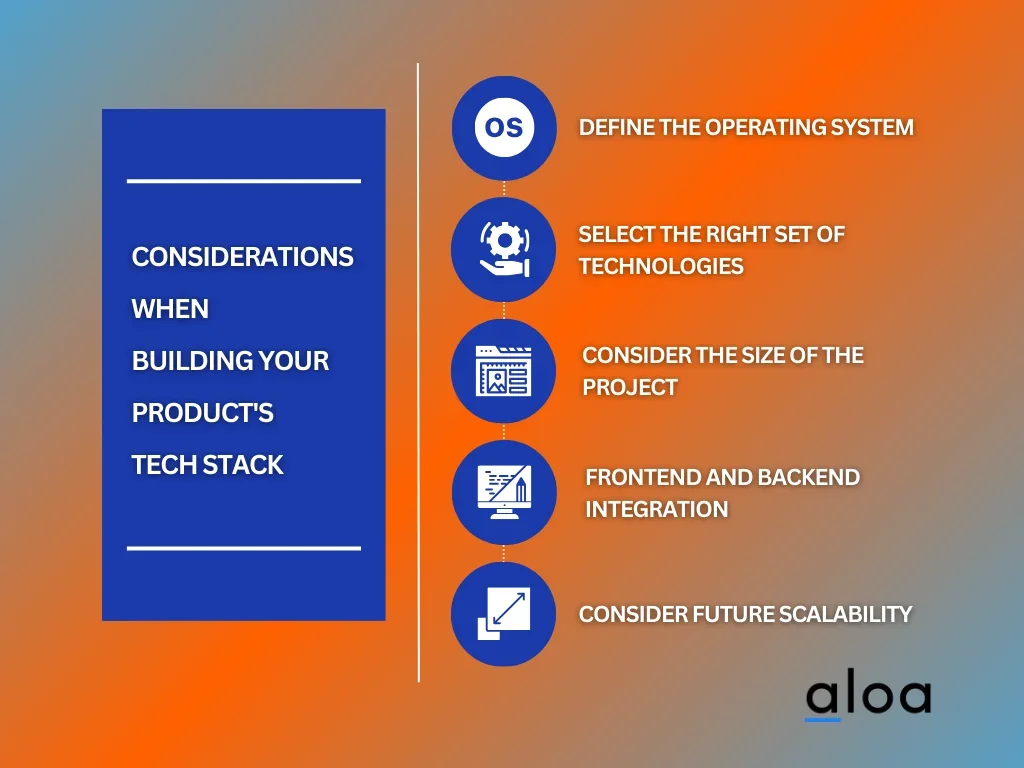
Define the Operating System
One of the foundational decisions you'll need to make is choosing the operating system (OS) that will serve as the backbone of your technology stack. The choice of OS can significantly impact your project's performance, scalability, and compatibility. Different OS options like Linux, Windows, or macOS offer distinct advantages and limitations.
For instance, Linux is renowned for its stability, security, and cost-effectiveness, making it a popular choice for web development and server hosting. On the other hand, Windows is favored for its compatibility with specific applications and development tools, particularly in the desktop software domain.
Select the Right Set of Technologies
The heart of your technology stack lies in selecting technologies that will power your project. You must carefully evaluate the available options and opt for the ones that align with your project's goals. Commonly used technology stacks include MEAN, MERN, and MEVN, all variations of the popular JavaScript-based stacks.
For instance, the MEAN stack consists of MongoDB, Express.js, Angular, and Node.js, offering a comprehensive solution for web app development. It leverages JavaScript across the entire stack, simplifying development and fostering code reusability.
Consider the Size of the Project
The size and scope of your project play a pivotal role in determining the appropriate technology stack. Smaller projects with limited complexity may benefit from a more straightforward technology stack, while larger endeavors may require a more robust and diverse set of technologies.
For instance, a serverless stack could be ideal for small to medium-sized projects where scalability and cost-efficiency are paramount. This approach allows you to focus on writing code without the burden of managing servers.
Frontend and Backend Integration
Efficient communication between your technology stack's front and back components is vital for a seamless user experience. You must ensure that your chosen frontend and backend technologies complement each other and can easily exchange data.
For example, pairing a frontend framework like React with a compatible backend technology like Node.js can streamline data processing and provide a unified development environment.
Consider Future Scalability
As your product grows and evolves, scalability becomes a critical concern. Choosing a tech stack that can accommodate your long-term scalability needs without requiring frequent overhauls is essential.
For instance, if you anticipate a surge in user traffic, selecting a technology stack that supports horizontal scaling and load balancing can ensure your application remains responsive and available during peak periods.
Benefits of Building Your Product's Tech Stack
Your tech stack is the backbone of your software solution, influencing everything from performance and scalability to user experience. Let's delve into the key benefits of investing time and effort in constructing an optimal technology stack for your project.

Enhanced Performance
A well-structured technology stack can significantly enhance the performance of your product. When you carefully select the right combination of technologies, frameworks, and tools, your application runs smoothly and efficiently. For instance, choosing the MERN stack (MongoDB, Express.js, React, Node.js) for web development ensures high front and back-end performance, resulting in faster load times and smoother user interactions.
Scalability and Flexibility
Scalability is critical in today's tech landscape, especially if your product is expected to grow. A modern tech stack allows you to scale your application effortlessly as your user base expands. Cloud-based solutions, microservices architecture, and containerization technologies provide the scalability and flexibility needed to adapt to changing demands.
Security and Vulnerability Mitigation
Protecting your product from vulnerabilities and security threats is paramount. A well-structured technology stack incorporates security measures and best practices from the ground up. Regular updates, encryption protocols, and security-focused libraries help safeguard your application against potential threats. Stay vigilant, mainly when dealing with user data, payment processing, or e-commerce solutions.
Streamlined Development Process
Choosing the right technology stack can streamline the development process, allowing your team to work efficiently and deliver results faster. When developers are familiar with the technologies they use, they can write clean, maintainable code and troubleshoot issues more effectively. Utilizing tools like TypeScript and automation solutions reduces development time and minimizes human errors.
Access to Modern Technology Services
A well-constructed technology stack provides access to many modern technology services and APIs. These services can significantly enhance the functionality of your product. For example, integrating Facebook login or payment processing APIs simplifies user authentication and facilitates secure transactions within your application. Leveraging AI and analytics services allows you to gather valuable insights and provide enhanced user experiences.
Key Takeaway
Building a well-constructed tech stack for your product is crucial for success. The knowledge gained in choosing the right technology stack can significantly impact your project's performance and scalability. It ensures that your technology infrastructure aligns with your business objectives, whether you're developing mobile apps, web pages, or business intelligence solutions. By understanding the different tech stacks available and their advantages, you can make informed decisions that enhance user experiences and streamline operations.
Contact us at [email protected] for expert guidance in selecting the ideal technology stack. Our skilled web developers and programmers can help you create a tailored solution stack that fits your needs. Don't compromise on performance monitoring and scalability; invest in the right tech stack to propel your project to success.

